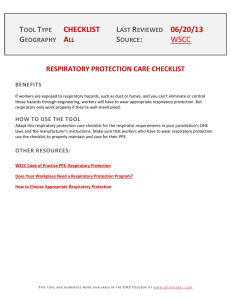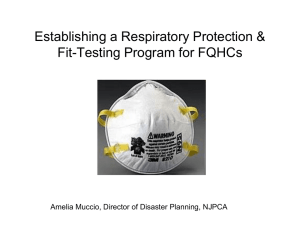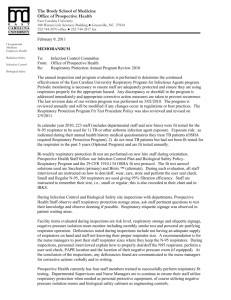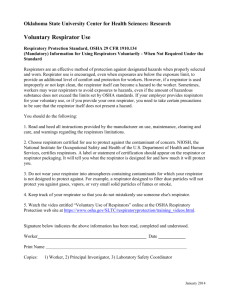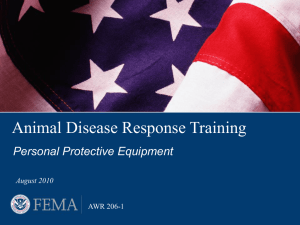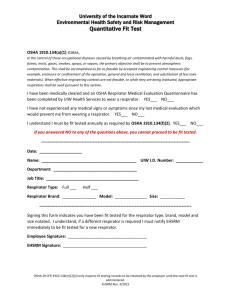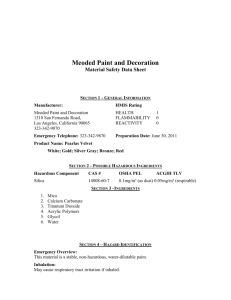Module 7: Respiratory Protection
advertisement
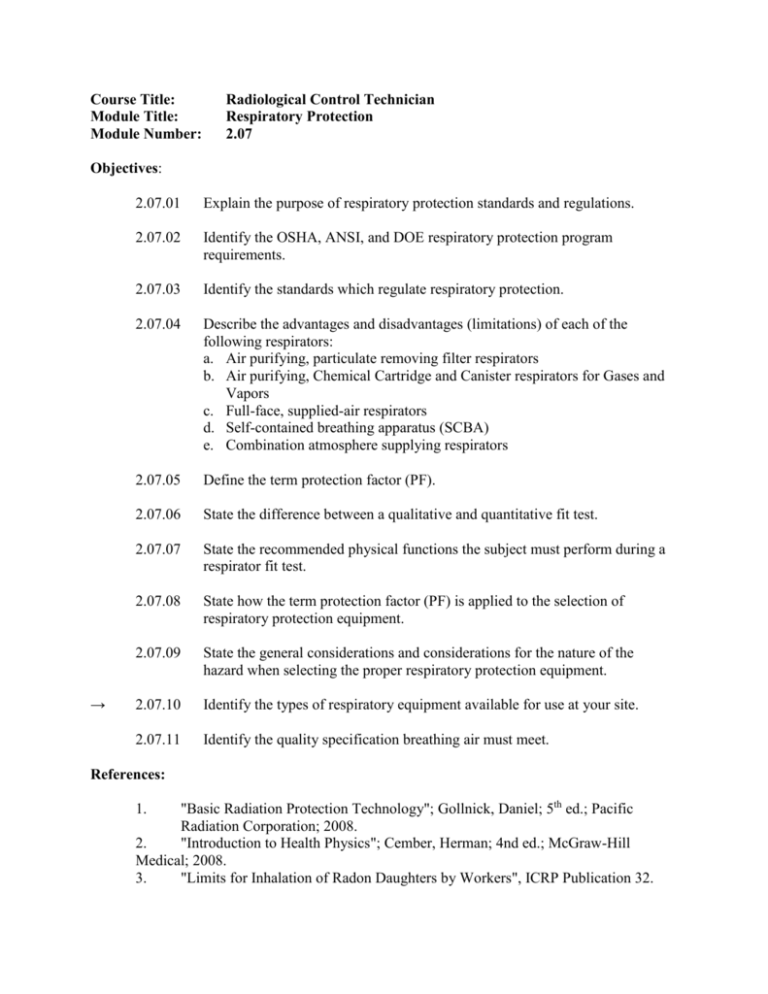
Course Title: Module Title: Module Number: Radiological Control Technician Respiratory Protection 2.07 Objectives: → 2.07.01 Explain the purpose of respiratory protection standards and regulations. 2.07.02 Identify the OSHA, ANSI, and DOE respiratory protection program requirements. 2.07.03 Identify the standards which regulate respiratory protection. 2.07.04 Describe the advantages and disadvantages (limitations) of each of the following respirators: a. Air purifying, particulate removing filter respirators b. Air purifying, Chemical Cartridge and Canister respirators for Gases and Vapors c. Full-face, supplied-air respirators d. Self-contained breathing apparatus (SCBA) e. Combination atmosphere supplying respirators 2.07.05 Define the term protection factor (PF). 2.07.06 State the difference between a qualitative and quantitative fit test. 2.07.07 State the recommended physical functions the subject must perform during a respirator fit test. 2.07.08 State how the term protection factor (PF) is applied to the selection of respiratory protection equipment. 2.07.09 State the general considerations and considerations for the nature of the hazard when selecting the proper respiratory protection equipment. 2.07.10 Identify the types of respiratory equipment available for use at your site. 2.07.11 Identify the quality specification breathing air must meet. References: "Basic Radiation Protection Technology"; Gollnick, Daniel; 5th ed.; Pacific Radiation Corporation; 2008. 2. "Introduction to Health Physics"; Cember, Herman; 4nd ed.; McGraw-Hill Medical; 2008. 3. "Limits for Inhalation of Radon Daughters by Workers", ICRP Publication 32. 1. 4. "Operational Health Physics Training Course", Moe, H.J., et. al., Argonne National Laboratory, Argonne, 88-26. 5. "Radiation Detection and Measurement", Knoll, G., John Wiley and Sons, New York, 2000. 6. 10 CFR 835, "Occupational Radiation Protection", 2007. 7. "Practices of Respiratory Protection", ANSI Z88.2, 1992. 8. "Manual of Respiratory Protection Against Airborne Radioactive Material",NUREG-0041, 1976. 9. Respiratory Protection, Federal OSHA, 29 CFR 1910, 134. 10. DOE-STD-1167-2003, DOE Respiratory Acceptance Program for Supplied-Air Suits. 11. CGA G7.1-1989, Breathing Air, Commodity Specification for Air 12. 10 CFR 851, “Worker Protection Programs”, 2007. 13. DOE Order 440.1B (2007), Worker Protection Management for DOE (including National Nuclear Security Administration) Federal Employees. 14. ANSI Z88.2 (1992). 2.07.01 Explain the purpose of respiratory protection standards and regulations. 2.07.02 Identify the OSHA, ANSI, and DOE respiratory protection program requirements. 2.07.03 Identify the standards which regulate respiratory protection. OSHA AND DOE REQUIREMENTS 10 CFR 851, for contractors, and DOE Order 440.1, for Federal employees, mandates the requirements for a respiratory protection program contained in 29 CFR 1910.134 and ANSI Z88.2. The Occupational Safety and Health Standard, 29 CFR, Part 1910.134, specifies the minimal acceptable respiratory protection program must contain or address the following: Written standard operating procedures and program governing the selection and use of respirators shall be established. Respirators shall be selected on the basis of hazards to which the worker is exposed. The user shall be instructed and trained in the proper use of respirators and their limitations. Respirators shall be regularly cleaned and disinfected. Those issued for the exclusive use of one worker should be cleaned after each day's use, or more often if necessary. Those used by more than one worker shall be thoroughly cleaned and disinfected after each use. Respirators shall be stored in a convenient, clean, and sanitary location. Respirators used routinely shall be inspected during cleaning. Worn or deteriorated parts shall be replaced. Respirators for emergency use such as selfcontained devices shall be thoroughly inspected at least once a month and after each use. Appropriate surveillance of worker area conditions and degree of employee exposure or stress shall be maintained. There shall be regular inspection and evaluation to determine the continued effectiveness of the program. Persons should not be assigned to tasks requiring use of respirators unless it has been determined that they are physically able to perform the work and use the equipment. The health care provider shall determine what health and physical conditions are pertinent. The respirator user's medical status should be reviewed periodically (for instance, annually). NIOSH approved or accepted respirators shall be used. The respirator furnished shall provide adequate respiratory protection against the particular hazard for which it is designed in accordance with standards established by competent authorities. These form the basis for any occupational safety respiratory protection program. ANSI Z88.2-1992 further specifies the minimal acceptable program for industries involved in the use of radioactive material, and addresses the following: Individual exposures limited by both inhalation and skin absorption Air sampling and bioassays Engineering controls as the primary method Individuals exposed to greater than the specified DAC or other exposure limits Respiratory protection equipment approvals (NIOSH) If allowance for the use of respiratory protection equipment in estimating radiation exposures is made, then the following must be observed: The protection factor must be sufficient to limit the annual internal dose considering the anticipated peak exposure concentration and associated DAC. If the exposure is later found to be greater than estimated, the corrected value shall be used, if less than estimated, the corrected value may be used. Surveys and bioassays conducted as appropriate to evaluate actual exposures. Written procedures for selection, fitting, maintenance, records, issuance and preuse operability checks of respirators, and supervision and training of personnel using respirators must be established. Prior to initial use and annually, determination by a qualified health care professional of a user's physical capability to wear a respirator must be performed. A written policy statement on use of engineering controls instead of respirators; routine, non-routine, and emergency use of respirators; and periods of respirator use and relief from respirator use must be issued. Each user must be advised that they can leave the work area upon failure of equipment, physical distress or deterioration of operating conditions. Equipment is to be used for appropriate environment and special equipment such as visual or communication devices are to be issued when needed. Emergency use equipment must be specifically certified as such by NIOSH. RESPIRATORY PROTECTION EQUIPMENT 2.07.04 Describe the advantages and disadvantages (limitations) of each of the following respirators: b. Air purifying, Chemical Cartridge and Canister respirators for Gases and Vapors Air Purifying, Chemical Cartridge and Canister Respirators for Gases and Vapors Description: Vapor and gas-removing respirators use cartridges or canisters containing chemicals (i.e., sorbents) to trap or react with specific vapors and gases and remove them from the air breathed. The basic difference between a cartridge and a canister is the volume of the sorbent. Limitations: These respirators do not provide oxygen, so they must NEVER be worn in oxygen deficient atmospheres. Unless specifically approved by DOE, no credit may be taken for the use of sorbent cartridges or canisters for protection against radioactive gases and vapors. High humidity environments may shorten the life of the sorbent material. 2.07.04 Describe the advantages and disadvantages (limitations) of each of the following respirators: c. Full-face, supplied-air respirator Atmosphere Supplying Respirators - Air Line Description: Air line respirators use a central source of breathing air that is delivered to the wearer through an air supply line or hose. The respirator type is either a tight-fitting facepiece (half face or full) or loose-fitting hood/suit. There are essentially two major groups of air line respirators - the air-line device and the hose mask with or without a blower. Hose masks are not used in power reactors; consequently, further discussion will be limited to demand, pressure demand, and continuous flow air line respirators. In a demand device, the air enters the facepiece only on "demand" of the wearer, i.e., when the person inhales. During inhalation, there is a negative pressure in the mask, so if there is leakage, contaminated air may enter the mask and be inhaled by the wearer. For this reason, demand respirators are generally no longer used. The pressure demand device has a regulator and valve design such that there is a flow (until a fixed static pressure is attained) of air into the facepiece at all times, regardless of the "demand" of the user. The airflow into the mask creates a positive pressure. The continuous-flow air line respirator maintains a constant airflow at all times and does not use a regulator, but uses an airflow control valve or orifice which regulates the flow of air. The continuousflow device does not guarantee a positive pressure in the facepiece. Limitations: Since the air line respirator provides no protection if the air supply fails, they shall not be used in IDLH atmospheres or for emergency escape or rescue. The trailing air supply hose severely limits mobility so it may be unsuitable if frequent movement among separated work stations is required. The length of hose, number of potential users, and pressure of the supply system can reduce the number of allowable users. Control of the air quality is essential to avoid introduction of hazardous respiratory agents to the wearers breathing zone. "Bubble suits" can aspirate air into the suit when the wearer lifts his arms. Consequently, the suit must be tested for the exact conditions of use. Special Considerations: Requirements for use of respirators in "dangerous" atmospheres is specified in 29 CFR 1910.134(e)(3) as follows: “(3) Written procedures shall be prepared covering safe use of respirators in dangerous atmospheres that might be encountered in normal operations or in emergencies. Personnel shall be familiar with these procedures and the available respirators. (i) In areas where the wearer, with failure of the respirator, could be overcome by a toxic or oxygen-deficient atmosphere, at least one additional man shall be present. Communications (visual, voice, or signal line) shall be maintained between both or all individuals present. Planning shall be such that one individual will be unaffected by any likely incident and have the proper rescue equipment to be able to assist the other(s) in case of emergency. (ii) When self-contained breathing apparatus or hose masks with flowers are used in atmospheres immediately dangerous to life or health, standby men must be present with suitable rescue equipment. (iii) Persons using air line respirators in atmospheres immediately hazardous to life or health shall be equipped with safety harnesses and safety lines for lifting or removing persons from hazardous atmospheres or other equivalent provisions for the rescue of persons from hazardous atmospheres shall be used. A standby man or men with suitable self-contained breathing apparatus shall be at the nearest fresh air base for emergency rescue." Manufacturers of airline respirators include instructions specifying a range of air required to produce at least the minimum required flow rates (4 CFM for tight fitting facepiece and 6 CFM for hoods). These specifications are based on hose lengths and the number of sections connected together. Determining if the proper air flow rate is achieved can be complicated by the use of a breathing air manifold supplying more than one user. The following are recommendations which should be considered. If all the hose lengths and number of hose fittings are the same, then a manifold with a single regulator and pressure gauge is appropriate for ensuring the proper pressure is used. (Note: If the pressure is within the manufacturer's specifications, then the delivery air flow rate should be at least 4 CFM for tight fitting respirators and 6 CFM for hoods). For situations where each user has different hose lengths, different number of connection or different air pressure requirements then a separate pressure gauge should be used as follows: The air flow rate should be measured at the end of the breathing tube (i.e., at the delivery end). This air flow rate should be measured using a calibrated rotameter or equivalent air flow measuring device. To utilize the Protection Factor (PF) assigned to air supplied hoods, a delivery flow rate of at least 6 CFM but not greater than 15 CFM must be obtained. The individual user's air flow valves should not be altered to maintain a minimum delivery flow rate of 6 CFM as this violates the NIOSH/MSHA approval. Taping or otherwise securing the airflow valves in the fully open position does not void the NIOSH/MSHA approval provided the valve is not permanently altered or made so that it would be impossible to increase or decrease the air flow by the user. 2.07.04 Describe the advantages and disadvantages (limitations) of each of the following respirators: d. Self-contained breathing apparatus (SCBA) Atmosphere Supplying Respirators - Self-Contained Breathing Apparatus (SCBA) Description: The self-contained breathing apparatus (SCBA) allows the user to carry a respirable breathing supply does not need a stationary air source such as a compressor to provide breathable air. The air supply may last from 3 minutes to 4 hours depending on the nature of the device. There are two groups of SCBAs - the closed circuit and the open circuit. Another name for closed circuit SCBAs is "rebreathing" device. The air is rebreathed after the exhaled carbon dioxide has been removed and the oxygen content restored by a compressed oxygen source or an oxygen-generating solid. These devices are designed primarily for 1-4 hours use in toxic atmospheres. An open circuit SCBA exhausts the exhaled air to the atmosphere instead of recirculating it. A tank of compressed air carried on the back, supplies air via a regulator to the facepiece. Because there is no recirculation of air, the service life of the open circuit SCBA is shorter than the closed circuit system. The only type of open circuit SCBA available for use is “pressure demand”. The pressure demand open circuit SCBA has a regulator and a valve design which maintains a positive pressure in the facepiece at all times regardless of the "demand" of the user. Because of the high degree of protection provided by the pressure-demand SCBA, this type of unit is recommended for emergency use, escape and rescue. There also exist combination atmosphere supplying respirators which utilize supplied air and an SCBA. 2.07.04 Describe the advantages and disadvantages (limitations) of each of the following respirators: e. Combination atmosphere supplying respirators. Combination Atmosphere Supplying Respirators Two types of combination supplying respirators are the combination pressure demand breathing apparatus and the dual purpose breathing apparatus. The combination pressure demand breathing apparatus provides respiratory protection for personnel who must work in atmospheres that are immediately dangerous to life or health (IDLH). When connected to a respirable air source, the device permits the wearer to work and move about freely, within the limits of the approved hose length. The combination pressure demand breathing apparatus is equipped with a small air cylinder which enables the wearer to escape from dangerous atmospheres in case the primary air supply is interrupted. The apparatus serves as a long duration work device and as an escape device as well. It is approved for respiratory protection for entry into, for extended periods of work in, and for escape from IDLH atmospheres. If used for entry into IDLH atmospheres, the air line must be connected before entry. The self-contained air supply is approved for escape only. Operation of the combination pressure demand breathing apparatus is manual. It is an approved, rated 5-minute escape device. The pressure demand air line respirator phase is connected by an approved air-supply hose to a primary respirable air source; the worker breathes from this source with the valve of the egress (exit) cylinder of the device turned off until the user is ready to leave the working area. If the primary air supply source should fail for any reason, the worker can switch to the egress cylinder by turning a valve and escape to a safe atmosphere. The worker then can leave, connected to the primary air source, or can open the egress cylinder valve and have approximately five minutes' respiratory protection. When breathing from the air cylinder, the user can remain connected to the primary air supply and exit, or can disconnect from the air source for easier escape. The dual purpose breathing apparatus combines all the capabilities of a self-contained breathing apparatus and a supplied-air respirator in one unit. The apparatus is approved by the NIOSH and MSHA for use in oxygen deficient atmospheres or where dangerous concentrations of toxic gases or vapors are present. The NIOSH/MSHA approval allows: The wearer of the apparatus to enter or exit a dangerous area using only the cylinder air in applications such as emergency rescue The wearer to work within the area for a limited time using the cylinder air The wearer to work within the area for an extended time using air from a supply line. Thus, the dual purpose breathing apparatus has all the advantages of both air and work masks. Note particularly that 20% of the cylinder air may be used for entry and that the apparatus is not limited to escape. Of course, if the air from the supply line should fail, the wearer can escape the area using the cylinder air. The dual purpose breathing apparatus is available in both demand and pressure demand models. In the demand model, air is supplied on demand at ambient atmospheric pressure. In the pressure demand model, a slight positive pressure is maintained within the facepiece during both inhalation and exhalation. The slight positive pressure prevents a toxic atmosphere from leaking into the facepiece; this type of leakage can occur with a demand apparatus due to the negative pressure developed in the facepiece. A pressure demand apparatus should therefore be used where the potential toxicity of the atmosphere is such that no back leakage can be tolerated. The regulator on the dual purpose breathing apparatus reduces the high pressure from the apparatus's compressed air cylinder to a breathable pressure. In pressure demand models, it also automatically monitors the flow of air into the facepiece so as to maintain a slight positive pressure within the facepiece. The regulator has two inlet ports - one for the cylinder and another for the supply line. A connector allows the air supply to be semiautomatically switched from the cylinder to the air line. With no supply line connected to the regulator, the wearer receives air from the cylinder. When an air line is connected to the regulator through the fitting, the wearer automatically receives air from the supply line. If the air supply from this line should be interrupted, the wearer must disengage the supply line in order to automatically receive air from the cylinder. Limitations of the Pressure Demand and Demand SCBA. The air supply is limited to the amount in the cylinder and therefore the respirator cannot be used for extended periods without recharging or replacing cylinders. Because these respirators are bulky and heavy, they are often unsuitable for strenuous work or use in confined spaces. The demand type SCBA works in a negative pressure mode and is considered obsolete. Special Considerations of the Pressure Demand SCBA. As specified in ANSI Z88.2, only the pressure-demand type SCBA should be selected for emergency use, rescue, and re-entry into a contaminated area to perform emergency shutdown or maintenance of equipment. The performance of SCBAs in high temperature environments, such as fires may lead to rapid deterioration of components. 2.07.05 Define the term protection factor (PF). PROTECTION FACTORS The overall protection afforded by a given respirator design is defined in terms of its protection factor (PF). The PF is defined as the ratio of the concentration of contaminant in the atmosphere to the concentration inside the facepiece or hood under conditions of use. Protection Factors may not be appropriate where chemical or other respiratory hazards exist in addition to radioactive hazards or where the mode of entry is through the skin and not through inhalation. For example, 50% of the intake from exposure to tritiated oxide is through skin absorption. The use of atmosphere supplying respirators will only provide a PF of 2. Application of PF's is relatively straight forward. The work area airborne radioactivity concentration is divided by the PF to estimate the inhaled concentration. For example, a worker performing steam generator eddy current testing with a full facepiece continuous air flow air line respirator (PF = 1000) and in an atmosphere of 1 x 10-6 uCi/cc Co-60 would be estimated to inhale a concentration of 1 x 10-9 uCi/cc Co-60. Table 1 - Assigned Protection Factors (29 CFR 1910.134)5 Type of respirator1, 2 Quarter Half mask Full Helmet/ mask facepiece hood Loosefitting facepiece 50 .............. .............. 1,000 425/1,000 25 3 1. Air-Purifying Respirator 5 10 2. Powered Air-Purifying Respirator .............. 50 (PAPR) 3. Supplied-Air Respirator (SAR) or Airline Respirator • Demand mode .............. 10 50 .............. .............. • Continuous flow mode .............. 50 1,000 425/1,000 25 • Pressure-demand or other .............. 50 1,000 .............. .............. positive-pressure mode 4. Self-Contained Breathing Apparatus (SCBA) • Demand mode .............. 10 50 50 .............. • Pressure-demand or other .............. .............. 10,000 10,000 .............. positive-pressure mode (e.g., open/closed circuit) Notes: 1. Employers may select respirators assigned for use in higher workplace concentrations of a hazardous substance for use at lower concentrations of that substance, or when required respirator use is independent of concentration. 2. The assigned protection factors in Table 1 are only effective when the employer implements a continuing, effective respirator program as required by this section (29 CFR 1910.134), including training, fit testing, maintenance, and use requirements. 3. This APF category includes filtering facepieces, and half masks with elastomeric facepieces. 4. The employer must have evidence provided by the respirator manufacturer that testing of these respirators demonstrates performance at a level of protection of 1,000 or greater to receive an APF of 1,000. This level of performance can best be demonstrated by performing a WPF or SWPF study or equivalent testing. Absent such testing, all other PAPRs and SARs with helmets/hoods are to be treated as loose-fitting facepiece respirators, and receive an APF of 25. 5. These APFs do not apply to respirators used solely for escape. For escape respirators used in association with specific substances covered by 29 CFR 1910 subpart Z, employers must refer to the appropriate substance-specific standards in that subpart. Escape respirators for other IDLH atmospheres are specified by 29 CFR 1910.134 (d)(2)(ii). 2.07.06 State the difference between a qualitative and quantitative fit test. RESPIRATOR FIT TESTING Definitions: 2.07.07 Qualitative fit test: Test to determine if there is any mask leakage, usually using irritant smoke ("Go/no-go" test but no measured value is assigned). Quantitative fit test: Test to determine quantity of mask leakage and assign a "fit factor," corn oil is the typical challenge atmosphere used (Measures concentration in mask due to leakage against concentration in atmosphere) or a particle counting instrument, such as a Portacount, which counts ambient particles in the air.. State the recommended physical functions the subject must perform during a respirator fit test. It is impractical to perform a quantitative fit test prior to each entry requiring respiratory protection. Therefore, qualitative tests are performed to ensure an adequate fit for the user. Qualitative tests can use challenge atmospheres such as Isoamyl Acetate (banana oil) or irritant smoke (e. g., stannic chloride) or as a negative or positive pressure test. The irritant smoke test is the most effective since the wearer's obvious discomfort from the smoke will show leakage through the respirator face seal. However, the test produces noxious odors for not only the wearer but those in the test area. The use of "banana oil" requires a subjective evaluation by the wearer and more often than not a user will not admit that in-leakage has occurred. One reactor respiratory program was faithfully utilizing the banana oil to perform the fit test and virtually all wearers indicated no in-leakage through the facepiece. Unfortunately, the respirator only contained a particulate filter cartridge rather than an organic vapor cartridge. Since most reactors use respirators at many different locations, challenge atmosphere tests are difficult to perform and therefore the "immediately prior-to-use" qualitative test normally selected is to perform a negative pressure test. Additional factors to be considered in fit testing acceptance criteria are the use of communication devices or sorbent canisters with respirators. The respirator approval is voided if any communication device is attached to the facepiece, unless the device is listed in the NIOSH/MSHA approval sheet. In addition to fit testing personnel, the respirator face pieces and cartridges must be periodically tested. Common practices are to test a portion of particulate cartridges upon procurement and to test all particulate cartridges prior to re-use. Anytime the filter is used by a different individual or on a different day by the same individual, the filter is considered as being reused and should be tested for efficiency, resistance and radioactive contaminants. As long as the inhalation valve for the respirator is in place and functions normally, concern for biological contaminants is of the filter is minimal. The subject performs at least the following functions during fit testing: 1) 2) 3) 4) 5) 6) 7) 8) 2.07.08 Normal breathing Deep breathing Moving head from side to side Moving head up and down Frown Talking Running in place Normal breathing State how the term protection factor (PF) is applied to selection of respiratory protection equipment SELECTION Equipment selected must be certified by NIOSH or specifically authorized by DOE. Approvals for respiratory devices are authorized in accordance with 42 CFR 84 and the device, type and certification number are listed in NIOSH publication entitled, Certified Equipment List. 2.07.09 State the general considerations and considerations for the nature of the hazard when selecting the proper respiratory protection equipment. Selection of the proper respirator for any given situation shall require consideration of the following: The nature of the hazard The characteristics of the hazardous operation or process The location of the hazardous area with respect to a safe area having respirable air The period of time for which respiratory protection may be provided The activity of the workers in the hazardous area The physical characteristics, functional capabilities, and limitations of respirators of various types The respirator-protection factors and respirator fit The following factors concerning the nature of the hazard requiring the use of respirators shall be considered in respirator selection: The type of hazard - Oxygen deficiency - Contaminant The physical and chemical properties The physiological effects on the body The peak and average concentrations of toxic material or airborne radioactivity level The established permissible time-weighted average or peak concentration of toxic material, or both, or established maximum permissible airborne radioactivity level (or administrative control levels for radiation dose) for radioactive substances Whether the hazard is an immediately-dangerous-to-life-or-health concentration of toxic material Warning properties Recognition and evaluation of the respiratory hazard (oxygen deficiency or contaminant(s)) shall be an essential part of selecting a respirator except in emergency or rescue operations. Initial monitoring of the respiratory hazard shall be carried out to obtain data needed for the selection of proper respiratory protection. The data should include: Identification of the type of respiratory hazard - Oxygen deficiency - Specific contaminants Nature of contaminants - Particulate matter - Vapors or Gases Concentration of respiratory hazard The following factors concerning the hazardous operation or process shall be taken into account in selecting the proper respirator: Operation, process, and work-area characteristics Materials, including raw materials, end products, and byproducts (actual and potential) Worker activities (Modification in the operation or process shall be taken into account, since this may change the hazard and hence require the selection of a different respirator.) Selection of air-line respirators includes not only the PF but also the air supply pressure, the air flow to the user and hose length. Each manufacturer's approval sheet lists the approved criteria. For use of 15 to 50 ft of hose at 16 to 20 pounds per square inch, an airflow of greater than 4 CFM to a facepiece, 6 CFM to a hood, and less than 15 CFM to either must be obtained. As discussed, air flow rate delivery should be evaluated for multiple personnel use of breathing air manifolds. 2.07.10 Identify the types of respiratory equipment available for use at your site. SITE RESPIRATORY EQUIPMENT (Insert site specific material here) 2.07.11 Identify the quality specifications breathing air must meet. AIR QUALITY TESTING An air quality testing program for all sources of respirable air is required. Compressed breathing air shall meet at least the quality specification for Grade D breathing air as described in Compressed Gas Association Commodity Specification G-7.1-1989. Section 5 of G-7.1 provides acceptable analytical procedures for measuring the respirable air components. Oxygen is easily measured using standard oxygen detectors which utilize an electrolytic reaction to generate a current proportional to the oxygen content. However, a number of reactors perform the measurement incorrectly as the oxygen percentage is determined by the partial pressures of the oxygen in the monitored atmosphere versus the calibrated atmosphere. The test is often performed by placing the detector probe directly in line with the pressurized supply line. Since the air is measured at an increased pressure, the partial pressure will appear greater relative to the calibration partial pressure and an overestimate of the oxygen concentration will result. A better method is to sample the oxygen in a plastic bag and then insert the probe and withdraw the air at a reduced pressure condition. Carbon dioxide and carbon monoxide are easily evaluated using either in line continuous monitors or grab sample "indicator tubes". The method at your facility will be determined by the designated Respirator Program Administrator. The test for condensed hydrocarbons is usually performed by filtering the air, weighing the filter and calculating the concentration by assuming the additional filter weight is due to condensed hydrocarbons. For service air systems, the air quality tests should also include monitoring for radioactive contaminants. The test for radioactive contaminants is necessary as a number of service air and breathing air systems have been cross contaminated from radioactive waste or auxiliary boiler contaminants. The frequency of performing air quality tests is not specified by regulation or in standards. For bottled air systems, such as SCBAs or respirator air supply cylinders, the tests should be performed on a representative sample of the bottles upon receipt at the facility. For facilities which compress respirable air and fill their own SCBAs, the sampling should be performed prior to each lot fill, once during the lot fill and once upon completion of the lot fill. For compressed air supply systems such as fixed station breathing air systems the sampling frequency is best performed prior to each use of a specific manifold system. However, this may be impractical during a major refueling outage where supplied respirable air is extensively used at different stations. In cases of heavy usage, then a daily check of the system may be more appropriate. SORBENTS AND PROTECTION AGAINST RADIOIODINES The regulations specifically prohibit the use of PFs for canister sorbents as protection against radioiodine atmospheres. The efficiency of the charcoal canister is dependent upon the chemical form of the radioiodine, humidity of the atmosphere, and breathing rate of the user. Approval can be obtained from DOE to use PFs for sorbent cartridges. A criteria for testing and certifying the charcoal cartridges is contained in NUREG/CR3403, "Criteria and Test Methods for Certifying Air-Purifying Respirator Cartridges and Canisters Against Radioiodine." A brief summary of test conditions and acceptance criteria are as follows in Table 2: Table 2 - Test Conditions and Acceptance Criteria Test Parameter Criteria Vapor CH3I Concentration 1 ppm Temperature 30 + 1 C Total Airflow 64 L/min Equilibration (6H at 64 L/min) All as received 3 at 50% RH 3 at 75% RH Maximum Penetration 01 PPM Minimum Service Life 30 min at 100% RH (extrapolated) 60 min at 75% RH Limiting conditions of use: Total challenge in the work place (radioactive iodine, non-radioactive iodine or the halogenated compounds) may not exceed 1 ppm. Temperature in the work area may not exceed 100 F. Temperature to be measured on each shift or in conjunction with operations which produce heat in the work area. Respirator wearers must have demonstrated a fit factor greater than 100 on the full facepiece respirator type to which the GMR-1 is attached. Service life is 8 hours maximum. This is calculated from the time the canister is unsealed and includes periods of non-use. Once the screw cap on the canister threads or the tape seal over the inlet port on the bottom are removed, the 8 hour use duration begins whether used or not by an individual. Canisters will not be used in the presence of organic solvents, vapors, or chemicals (such as decontamination compounds, lubricants, volatilized paint, alcohol, freon) which could cause aging, poisoning or desorption of the adsorbed radioiodines. Non-exposure to these organic agents must be demonstrated by usage restrictions and by air sampling. Canisters must be stored in sealed humidity-barrier packaging in a cool, dry environment (QA Class "A" storage). COMMUNICATIONS Although conventional respirators distort the human voice to some extent, adequate communication can be maintained in relatively quiet areas. For power reactors, those areas requiring the greatest use of respiratory protection are often the noisiest due to the numerous pumps, motors and fans. Consequently, special attachments or modifications to the respiratory device are often needed to ensure adequate communication. A mechanical speech-transmission device, called a speaking diaphragm, is an integral part of the facepiece in some respirators. It usually consists of a resonant cavity and diaphragm which transmit sound. The diaphragm also acts as a barrier to the ambient atmosphere and thus should be handled carefully to prevent possible puncture which would permit leakage of an air contaminant into the respirator. Various methods of electronically transmitting and amplifying speech through the respirator are available. These utilize a microphone connected to a speaker, telephone, or radio transmitter. Usually, the microphone is mounted inside the respiratory-inlet covering, while the amplifier, power pack, and speaker or transmitter are attached to the exterior of the respiratory-inlet covering, carried on the body, or remotely located. Respirators with electronic speech-transmission devices having a battery power supply should be used with caution in explosive atmospheres. Sealed power sources shall be checked for integrity of the seals. Connecting cables from the microphones inside the respiratory inlet covering shall have gas-tight seals where they pass through the covering. When the speaker diaphragm is part of the barrier between the respirator wearer and the ambient atmosphere, it shall be and should be adequately protected from puncture or rupture. A microphone mounted on the respirator wearer's throat or head or a microphone/speaker worn in the respirator wearer's ear does not require penetration of a respirator facepiece by a cable. Any communication device that is an integral part of the respirator or is attached to the exterior such as a sound transducer on the face plate, must be part of the NIOSH approval for the respiratory device. SUMMARY All respiratory protection devices share a common limitation for protection against hazardous substances which injure the skin or eyes (except SCBAs) or are absorbed through the skin. When selecting any protective device, the chemical form of the hazardous substance should be ascertained to determine if skin protection is required and if the eye protection afforded by the respirator is adequate. This page intentionally left blank.
